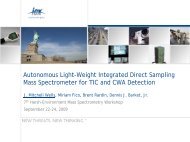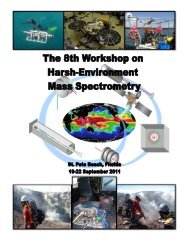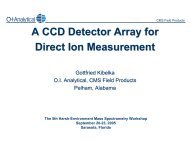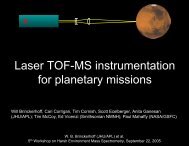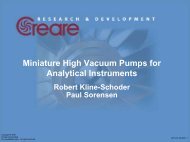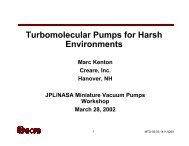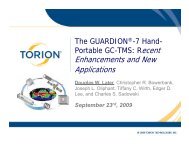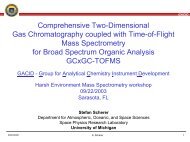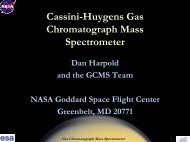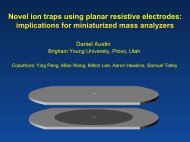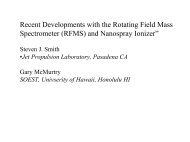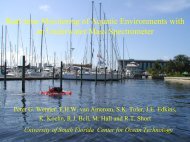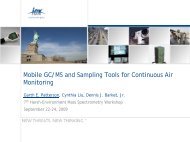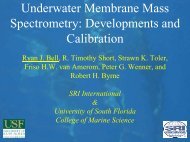Development of the DOMS Deep-Ocean Mass Spectrometer System
Development of the DOMS Deep-Ocean Mass Spectrometer System
Development of the DOMS Deep-Ocean Mass Spectrometer System
Create successful ePaper yourself
Turn your PDF publications into a flip-book with our unique Google optimized e-Paper software.
<strong>Development</strong> <strong>of</strong> <strong>Mass</strong> <strong>Spectrometer</strong>-<br />
based Instrumentation for Monitoring<br />
<strong>Deep</strong>-<strong>Ocean</strong> and Terrestrial<br />
Processes<br />
Gary M. McMurtry<br />
Dept. <strong>of</strong> <strong>Ocean</strong>ography<br />
School <strong>of</strong> <strong>Ocean</strong> & Earth Science & Technology<br />
University <strong>of</strong> Hawaii
Research Team<br />
• Gary McMurtry, , PI, <strong>Ocean</strong>ography Dept., SOEST<br />
• Lloyd French, , project engineer, Hawaii Institute <strong>of</strong> Geophysics &<br />
Planetology<br />
• Gindi French, technical assistant, <strong>Ocean</strong>ography Dept.<br />
• Arnaud Bossuyt, , graduate student, <strong>Ocean</strong> Resources & Engineering<br />
Dept.<br />
• Bernhard Chapligin, , student trainee, University <strong>of</strong> Karlsruhe,<br />
Germany<br />
• Technical support from SOEST Engineering Support Facility<br />
David Copson, , ME<br />
James Jolly, , EE<br />
Michael Cole, , machinist
Goals <strong>of</strong> Research<br />
• In situ analysis <strong>of</strong> a variety <strong>of</strong> dissolved gases and volatile organic<br />
compounds, using MIMS<br />
• An extended presence in <strong>the</strong> deep ocean for monitoring long-term<br />
seafloor processes, with several months to a year deployment, using<br />
battery power<br />
• High sensitivity, simultaneous chemical analysis with only modest<br />
power consumption<br />
• Reasonably high precision and accuracy via lab MIMS calibration<br />
and in situ T, P corrections<br />
• Make instrument as compact and light as possible<br />
• Investigate volcanic gas monitoring with similar instrumental<br />
approach
<strong>Mass</strong> <strong>Spectrometer</strong> Pros & Cons<br />
• Pros<br />
=> Multi-molecular, quasi-simultaneous simultaneous analysis possible<br />
=> High sensitivity analysis (ppb to ppt)<br />
=> Reasonably compact & robust MS now available<br />
=> Promise <strong>of</strong> isotopic analysis<br />
=> Applications are diverse and growing<br />
• Cons<br />
=> Usually a large lab instrument with high power consumption<br />
=> Most MS require high vacuum (10 - 5 Torr or better = power)<br />
=> What to do with waste gas in a pressure housing?<br />
=> High precision requires frequent calibration<br />
=> Expensive, unless self-made
SRS QMS-200 Bench-Top<br />
Quadrupole MS<br />
Vac. Gauge<br />
Solenoid<br />
Valves<br />
High-Vac.<br />
MS Electronics<br />
Turbo<br />
Pump<br />
Rough<br />
Pump<br />
<strong>Mass</strong> Spect.<br />
Turbo<br />
Controller
Quad mass spectrum--<br />
--moist air
<strong>Deep</strong>-<strong>Ocean</strong> <strong>Mass</strong> Spect. . (<strong>DOMS</strong>)<br />
Features:<br />
• MIMS tested to 400 bar (4,000 m water depth equivalent)<br />
• Capable <strong>of</strong> deployments <strong>of</strong> months to a year on batteries<br />
• Capable <strong>of</strong> real-time data via acoustic or light telemetry<br />
• Capable <strong>of</strong> simultaneous multi-molecular monitoring<br />
<strong>of</strong> dissolved gases & volatile organic compounds
Volcanic fumarole sampling<br />
- <strong>the</strong> old fashioned way<br />
Iwodake Volcano, Satsuma Iwojima, Japan<br />
700° C fumarole<br />
People Die Doing this Stuff!<br />
Galeras Volcano, Colombia<br />
225° C fumarole
Volcano <strong>Mass</strong> Spect. . (VMS)<br />
Features:<br />
• Designed for corrosive gas resistance (volcanic gases)<br />
• Capable <strong>of</strong> long-term deployments, using solar panel<br />
• Capable <strong>of</strong> real-time data via wireless or cabled<br />
telemetry<br />
• Capable <strong>of</strong> simultaneous multi-molecular monitoring<br />
<strong>of</strong> dissolved gases & volatile organic compounds
Ti corrosion-resistant resistant housing
Bench test - VMS
Sulphur<br />
Bank,<br />
Kilauea test<br />
97°C fumarole
<strong>Mass</strong> scans, Sulphur Bank
Preliminary results, Sulphur Bank
CAD Layout & Result- <strong>DOMS</strong>
Membrane Introduction <strong>Mass</strong><br />
Spectrometry (MIMS)<br />
Hollow Fiber versus Sheet Membrane<br />
LaPack et al. (1996)
METS Methane Sensor<br />
METS sensor specification:<br />
Measuring range:20 nmol/l to 10 µmol/l<br />
o<strong>the</strong>r ranges on request between 20 nmol/l and 1 mmol/l<br />
Resolution: at 50 nmol/l approx. 4 to 5 nmol/l<br />
Response time: 3 to 30 min, conditionned to turbulences<br />
Pressure range: 200 bar (o<strong>the</strong>r ranges on request)<br />
Operational range: +2 to +20°C (o<strong>the</strong>r ranges on request)<br />
Electrical data:<br />
Power supply: 12 V (9 to 36 VDC)<br />
Power consumption: 230 mA (switch-on peak 400 mA)<br />
Analogue output: 0 to ~ 5 V for methane, temperature<br />
and humidity
MIMS and chassis layout
High-Pressure Test <strong>of</strong> MIMS Membrane
Energy Budget-<strong>DOMS</strong><br />
instruments Voltage (V) Current (A.) Power (W) time(sec) Watt/sec Power (W) time(sec) Watt/sec Watt/sec<br />
(in order <strong>of</strong> operation) peak peak peak steady steady steady total<br />
Seabird (temperature probe) 9 0.01 0.09 0.09 10 0.9 0.9<br />
By pass SV (vacuum valve) 24 0.50 12.00 12.00 600 7200 7200<br />
Hi. Vac. SV (behind aperture) 24 0.50 12.00 12.00 600 7200 7200<br />
Waste SV (vacuum valve) 24 0.50 12.00 12.00 600 7200 7200<br />
Diaphragm Pump 24 0.63 15.00 15.00 600 9000 9000<br />
Turbo Pump 24 3.90 93.60 150.0 14040.0 21.60 390 8424 22464<br />
RGA (quadrupole MS) 24 2.50 60.00 60.00 360 21600 21600<br />
60624.9 74664.9<br />
Watt/hr. 20.7<br />
total battery Watt/hr. alkaline 3000.0<br />
7" dia. X 24" # samples 144.6<br />
lithium 6000.0<br />
# samples 289.3<br />
Ten minute sample period @ 1/day = 145 days (4.5 months) alkaline,<br />
289 days (>9 months) lithium
Waste Vacuum Experiment<br />
About 7+ days <strong>of</strong> continuous sampling…may not be a problem.
Carbon Flux from Margins-<br />
Chemical <strong>Ocean</strong>ography Program, NSF
Costa Rica margin seeps<br />
Active Margin Gas Hydrate Province<br />
ODP Leg 170 results<br />
Ruppel & Kinoshita (2000)
Costa Rica Cold Seep Mounds
Costa Rica Margin Deployment
SIO Chemical and Aqueous Transport<br />
(CAT) Meter<br />
Clever method for long-term chemical monitoring at minimal power--<br />
The major drawback is “after-<strong>the</strong>-fact” sampling approach.
CAT meter - Monterey Bay results<br />
Figure 2. Fluid chemistry as a function <strong>of</strong> date for <strong>the</strong> March, 2004 CA T deployment at<br />
Monterey Bay.<br />
D. Hilton & K. Brown,<br />
pers. comm., (2004)<br />
Figure 3: Relative changes in flow rate (upper) correlating with temperature fluctuations<br />
(lower). Both records show <strong>the</strong> influence <strong>of</strong> (deep) source fluids with an overprint <strong>of</strong> tidal<br />
loading.
Deployment Mainframe Test
Final Assembly-<strong>DOMS</strong>
Attaching<br />
<strong>the</strong> Waste<br />
Vacuum<br />
Chamber
Final Shipboard Assembly & Test
Over <strong>the</strong> side--<br />
--R/V Atlantis
Alvin Deployment,<br />
1000-m, Costa Rica Margin
METEOR M66<br />
Leg 2b: ROV Quest (MARUM, Bremen)
O<strong>the</strong>r & Future Research Directions<br />
<strong>Mass</strong>SURFER Aqueous<br />
Monitoring with RFMS<br />
In situ Isotopic 16 O, 17 O, 18 O<br />
Analysis <strong>of</strong> O 2 by Sector/Cycloid MS<br />
Plenum<br />
N 2 Purge<br />
MIMS<br />
Assembly<br />
Nafion<br />
water trap<br />
TC-100<br />
2-way solenoid<br />
valves (n=3)<br />
aperature<br />
Pfeiffer<br />
Turbo<br />
Internal Standard<br />
Magnetic Sector MS<br />
+ Ionizer + Detectors<br />
24VDC<br />
Int. Batt.<br />
1-atm.<br />
housing<br />
Diaphram<br />
Mini-pump<br />
Waste Vac.<br />
housing<br />
RS-232<br />
Ext. Batt.<br />
Vac. Purge<br />
Temp. probe<br />
Detached Turbo<br />
Controller<br />
PC/104<br />
Electronics<br />
removable<br />
Waste Vac.<br />
getters
Conclusions<br />
• We are on our way toward a long-term<br />
in situ analysis tool on <strong>the</strong><br />
seafloor using MIMS. Real-time and long-term analysis in <strong>the</strong> field<br />
should be possible<br />
• Power is still a problem, but can be overcome by additional<br />
batteries, fuel cells, or a power cable<br />
• Waste vacuum appears not to be a big problem (at present rates)<br />
• ASD membrane can go deep (> 4 km--<br />
--a a record), but 10 µm<br />
thickness has rapid diffusion characteristics under vacuum<br />
• Volcano monitoring looks feasible, but water vapor is a major<br />
problem--<br />
--will know more soon<br />
• Costa Rica deployment in 2005 will <strong>of</strong>fer in situ ground truths<br />
• O<strong>the</strong>r in situ MS approaches (aqueous and isotopic) are promising



